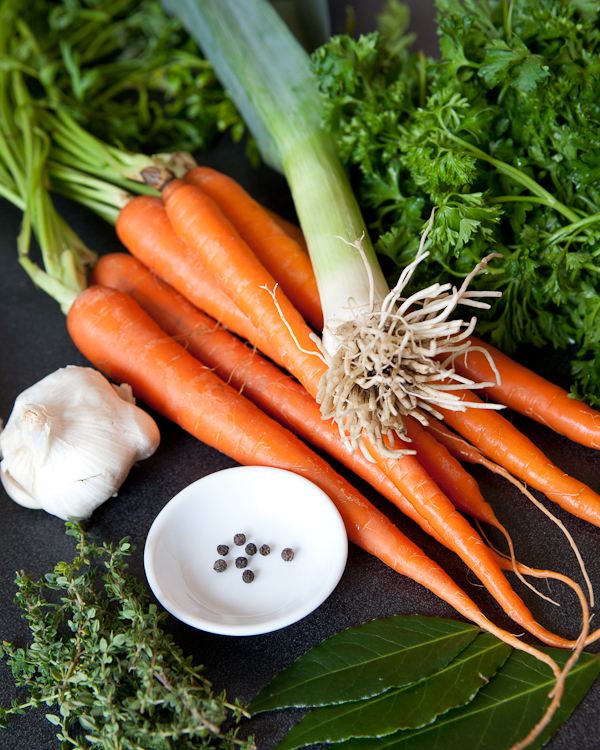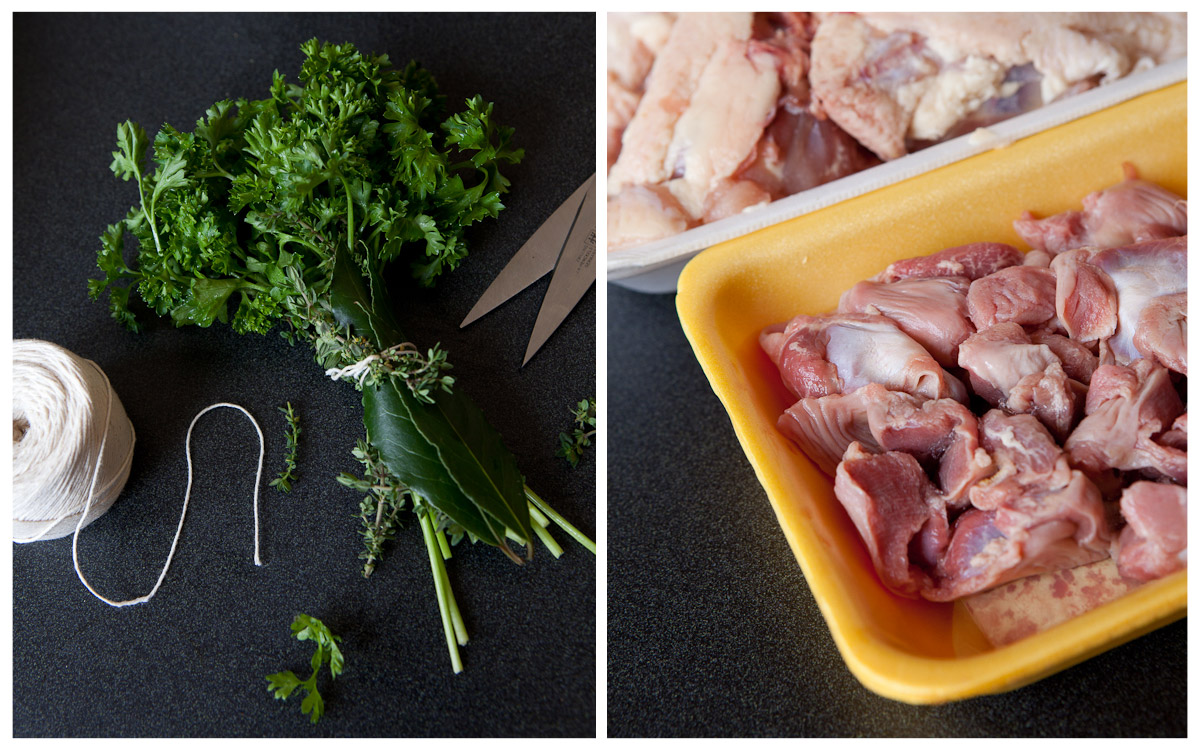The more I time I spend reading cookbooks the more I’m starting to realize just exactly how many recipes call for stock. Even recipes that aren’t soup require the stuff, it’s like the crack of the food world. Cooks can’t get enough. So I’m going to have to figure this stock situation out. In the past I would probably just go buy some pre-made stock and get started with my recipes. But now I’m a food blogger! So I must do everything! The hard way! And to think, my life used to be so easy, dry cereal out of the box for dinner etc.
So. I decided to make stock.
I started out by hitting up several of my cookbooks for a recipe. Unsurprisingly, many of my cookbooks have at least a basic recipe for stock. One of my newer cookbooks, The Seasonal Kitchen has no less than nine different stock recipes. Most of them say to use leftover meat bits, like chicken necks and backs. Lots of them call for chicken bones, beef bones, and veal bones, not to mention veal knuckles and calves feet. These are all things that I would have if I was butchering my veal here in my apartment. Unfortunately (since I couldn’t carry it on the plane) the awesome cleaver I found in my parents basement won’t get here until Friday. So no butchering in the apartment for me.
Of course I can get all of the animal parts I’d need from an actual butcher but frankly I haven’t found a good one yet. Part of the issue is that I am getting some ambiguous advice about which butcher to go to (if you have any strong feelings about a St. Louis butcher, hit me up in the comments). Also I am feeling shy about asking for help when I get to the counter. Which clearly I need to get over. Because I’m a grown man. And grown men should not be afraid of the butcher. For now though I decided to go with a simple chicken stock as a starting point, and I’ll work my way up to veal knuckles later.
My shopping list for my stock included 4 lbs of chicken parts, an onion, carrots, celery, a leek, fresh thyme, fresh parsley, bay leaves, and garlic. In addition I needed eight peppercorns. Nearly all of the recipes that I read call for exactly eight peppercorns. So thats what I’m going with – I wouldn’t want to ruin my stock with, say, nine peppercorns. Many of the recipes also call for a bouquet garni (which basically means that you tie all of the fresh herbs together). I don’t think that this is strictly necessary since you filter out all of the solids at the end anyway. However, the bouquet does look nice in the photographs.
Since I didn’t have four pounds worth of chicken bits sitting around my apartment or in my freezer, I headed to the grocery store to buy my supplies. I read that chicken legs are inexpensive and will work well, so that was how I was planning to fulfill the meat portion of my shopping list. Much to my surprise when I got to the grocery store, I was able to buy three pounds of chicken necks and backs plus a pound of chicken gizzards all for less than the cost of half their weight in legs. Who knew they sold the junk parts by themselves? I guess everyone but me. All told the supplies for my stock came in around $15. The largest expense was the herbs which I had to buy in packs which held about four times as much as I needed. If I’d been growing my own herbs as I plan to do this summer, the whole pot of stock would be well under $10. Even if you buy it in bulk, a single quart of chicken stockis going to run you three bucks or so.
Next I needed to focus on hardware. My largest pot was a 8 quart dutch oven which is a little small for stock. My research tells me that a tall, slender pot is ideal rather than a short, wide pot as the lower surface area means less evaporation. So the top of my shopping list was a 12+ quart stock pot. I ended up with a 12 quart multi-cooker which came with some strainers which I thought would be useful for other cooking later. I kinda wish it would have had a metal lid instead of a glass lid, but as an American consumer I wanted it today. And so I settled. I also came home with mason jars (for storage), and cheesecloth, to help filter out the solid matter at the end of the process.
So fully armed with chicken necks, backs and gizzards, along with the appropriate hardware, I’m ready to cook stock. Part Two of Stock Investment comes tomorrow, unless I utterly fail and have to dump the whole mess into the garbage disposal. I know, isn’t this exciting? The first Shoot To Cook cliff-hanger! Cue the dramatic music!




4 Comments
Stock Investment (Part 2) « Shoot to Cook
December 1, 2010 at 8:27 am[…] Gear « Stock Investment (Part 1) […]
Ericka
December 1, 2010 at 6:29 pmI must get over my laziness when it comes to making chicken stock. And demiglace.
Skillet Roast Chicken « Shoot to Cook
December 16, 2010 at 8:09 am[…] packet of spare parts from the interior of the chicken (put them in the freezer and save them for stock). Rinse your bird briefly and dry carefully. Excess water will cause the bird to steam rather than […]
French Onion Soup « Shoot to Cook
December 20, 2010 at 8:15 am[…] recipe called for 8 cups of water, and my thinking was, why use water when I can use some of my awesome chicken stock? I bet beef stock would work well here as well. Also the original recipe was specific about using […]